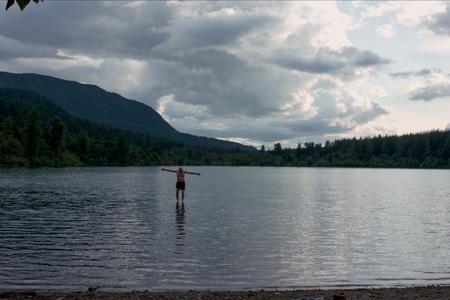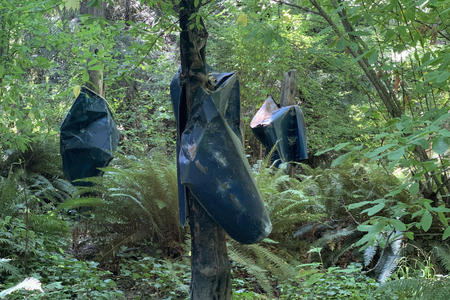Those who aren’t vaccinated — as in, “individuals with a medical condition or closely held religious beliefs” and children under 12, the emails clarified — may instead present a negative COVID-19 test taken within 48 hours of the curtain rising.
ArtSEA: Notes on Northwest Culture is Crosscut’s weekly arts & culture newsletter.
STG Presents (which runs The Paramount, Neptune and Moore theaters) was ahead of the pack of local performance venues, having announced similar requirements a couple of weeks ago. Seattle Arts and Lectures followed last week.
All of which means we’re embarking on yet another phase of our pandemic reality. In this one, arts patrons will line up to show vax cards to ushers and mingle in the lobby wearing masks that either coordinate or clash with the evening’s outfit.
If sipping a glass of wine or nibbling on a cookie, they’ll either pull the mask down into “chin hammock” mode, or slip the straps gently over the wrist, like an avant-garde cloth bracelet. Settling into seats, they’ll secure the masks back in place. (Bonus: audience members who never fail to cough in quietly tense moments on stage will at least be somewhat muted.)
It’ll be quite a sight in a grand auditorium. And then, like everything else we’ve adjusted to (remember when those plexiglass panels bolted onto cashier counters looked weird?), it will all seem ordinary.
This month, we’ll continue our cultural activities outdoors, with events like the Seattle Design Festival (Aug. 21-22, 10 a.m.-7 p.m., free). Now in its 10th year, this interactive, immersive weekend showcases bright and bold ideas from local design and architecture firms seeking ways to improve our regional quality of life.
The theme — Emerge — probably seemed perfect when they chose it several months back, but with the delta variant wreaking havoc, it now sounds a tad optimistic. Nevertheless! I’ve attended the Seattle Design Festival many times in the past decade, and it’s always an engaging and eye-opening event, with a good mix of clever, fun and solutions-oriented ideas. This year the built installations and pop-ups will all be at Lake Union Park (near the Museum of History and Industry and the Center for Wooden Boats).
Based on the schematics I’ve seen, artful takes on tunnels will abound — which makes sense as they suggest moving through something dark and coming out the other side, rattled but stronger for it. Hey, it’s worth a shot — walk through a few and see how you feel.
You can also pen your pandemic worries onto a paper boat and set it adrift, smoosh yourself into a giant inflated poof (courtesy of the playful geniuses at Seattle Design Nerds) and thereby trigger a “polyphonic phorest” soundscape, explore new takes on tiny homes, emerge from a fabricated “fog,” make your way through a stringed labyrinth and witness a human-scale web of facemasks (too soon?).
Also at the festival is a display of work by several emerging artists who are illuminating the local landscape with electrifying murals and eye-popping installations: Nikita Ares, Colleen Louise Barry, Mary Anne Carter and Stevie Shao, the last of whom Crosscut’s Margo Vansynghel profiled earlier this week.
And there’s more outdoor art to explore this weekend, including Marisol, a darkly comic dystopian drama from innovative local theater company The Williams Project (Aug. 19-29 in Georgetown); Music at the Mural with Ethiopian/Eritrean band Guzo, and Sistas Rock the Arts (Aug. 22 at noon at Seattle Center); and, on Vashon Island, a “performance treasure hunt” from local dance theater company Kinesis Project, featuring maps and movement at secret locations (Aug. 22 at 5:30 p.m.).
Regular readers know I’ve been on a bit of a treasure hunt myself recently, after chancing upon a mysterious bronze plaque along a trail at Point No Point Park. Immediately after I published the Kitsap Peninsula mystery in the last newsletter, a handful of astute ArtSEA readers emailed with clues to help me solve it.
Spoilers ahead! Turns out the bronze cast I found — a regal bird head imbued with Coast Salish design elements — was part of a countywide scavenger hunt Kitsap County Parks and Recreation orchestrated in 1992-93. The idea was to get people outdoors and, in the process, foster education about the regional geography and watershed, including the roles played by glaciers, rain, rivers, lakes, estuaries and Puget Sound.
Reader Rebecca Pirtle, a former regional newspaper reporter and editor, was the first to inform me that the project was called Tracking the Thunderbird (hence my fruitless Googling — I was using “eagle” and “seahawk” as search terms). Nine different Thunderbird “tracks” (the bronze plaques) were designed by a variety of local artists and installed in parks across the county. Other community members wrote riddles and clues to hint at their secret locations.
The track I stumbled upon at Point No Point was designed around the topic “glaciers.” The clue (which you can read in full here) included a rhyme that began:
The name of the place has no point, you say?
I disagree, it’s all a word play!
In a park just south of the flashing eyes,
Is where the Thunderbird’s first track lies.
The place is Point No Point, and the flashing eyes are the lighthouse, see?? This stuff is catnip for someone like me. (As a kid I was obsessed with solving the visual riddles in the 1979 book Masquerade, which promised a real-life treasure buried in England. Anyone else?)
You can still find many of the tracks — the clues are all here, and almost all (except for the Point No Point track, frustratingly) include the names of the people who designed the bronze pieces and wrote the riddles. But as a 2017 article in the Kitsap Sun noted, a few of them have disappeared. Track No. 3 (“rain”) was chipped out of the concrete and stolen. Track No. 5 (“streams”) may have, appropriately, washed away.
Undaunted, last weekend I went out in search of Track No. 9 (“Puget Sound”), which I had deduced from the associated clues would be located in Fay Bainbridge Park. I dragged several friends out to the northern tip of Bainbridge Island, where we looked all over the beach. Sustaining ourselves on abundant wild blackberries, we began to lose hope after a while — maybe it had been buried in sand over the last 30 years? But then, a friend called from across the beach, “Does it look like a seahawk?” And there it was! Where exactly? I’m not telling.
Get the latest in local arts and culture
This weekly newsletter brings arts news and cultural events straight to your inbox.









